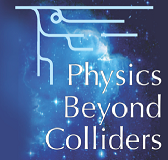Speaker
Description
The NA64 is a fixed-target experiment aiming to search for dark sector physics with a high-energy electron beam at the CERN SPS. The experiment uses a new approach combining the active beam dump and missing energy techniques. We present the future NA64 research program which is significantly extended
%and has a certain advantages compared to the classical beam dump approach.
by the inclusion of measurements with high-energy $\mu,~\pi,~K$, and $p$ beams. The program will deliver a rich and compelling physics opportunity by performing the sensitive searches for new symmetries, rare decays, and weakly-interacting particles from the dark sector and is based on the following motivations:
i) In addition to gravity, there might be another very weak interaction between the ordinary and dark matter transmitted by a new $U'(1)$ gauge boson (dark photon). NA64 plans to search for visible, e.g. into
$e^+e^-, ~ \mu^+ \mu^-$, and invisible, e.g. into dark sector particles, decays of sub-GeV dark photons. The experiment has the exciting opportunity to probe a substantial fraction of the currently unexplored dark photon parameter space, probing kinetic-mixing parameter $\epsilon$ as low as $\epsilon^2 \simeq 10^{-6} -10^{-10}$ and masses $M_{A'}\leq 500$ MeV by using $\simeq$ 100 GeV electron beams from the CERN SPS. The search will also cover the region
where the $(g-2)_\mu$ discrepancy between the measured and predicted anomalous magnetic moment of the muon can be explained by an additional $U'(1)$ gauge boson which decays mostly invisibly.
%With an expected number of electron on target $10^{12}( 10^{13})$ in 2016-2017 (2018 and beyond).
ii) A new sub-GeV gauge boson $\zm$ (leptonic boson) from the $L_\mu - L_\tau$ flavor symmetry with couplings to $\mu$ and $\tau$, but not electrons, could explain the $(g-2)_\mu$ discrepancy and the gap of high-energy neutrinos in IceCube, and is well motivated by neutrino mixing angles.
The $\zm$ could be observed in the reaction $\react$ of high-energy muon scattering off nuclei by looking for an excess of events with the large missing muon beam energy in a detector due to the prompt bremsstrahlung $\zm$ decay $\zmnn$ into a couple of neutrino. \
The availability of high energy ($\simeq 100$ GeV) and high intensity ($\simeq 10^6$/spill) muon beams at CERN SPS allows to search for the $Z'$ with the sensitivity in coupling constant $\alpha_\mu \simeq 10^{-11}$, which is three orders of magnitude higher than the value required to explain the
$(g-2)_\mu$ anomaly. This provides a unique opportunity either to discover or rule out the $\zm$ in the proposed search in the near future.
%The number of muons available at present is an order of $10^{15}$ $\mu$/year, and it is anticipated to have more like $10^{18}-10^{19}$ $\mu$/year.
iii) In the standard model (SM) the rate of the neutral mesons $(M^0)$ $\pi^0, \eta, \eta', K_S, K_L \to \nu \overline{\nu}$ decays is predicted to be extremely small. The decay $K^0_L (K^0_S)\to invisible$ has never been experimentally tested. In the SM its branching ratio for the decay into two neutrinos is helicity suppressed and predicted to be $\leq 10^{-10}$. In several popular extensions of the SM, e.g. the two-Higgs doublet model, the helicity suppression factor can be avoided resulting in the enhanced $K^0_L$ rate e.g. into $\nu_\tau \overline{\nu}_\tau$ pair or pair of light scalars, and could be in the range $Br(K^0_L \to invisible) \simeq 10^{-8}-10^{-6}$, still allowed by the most stringent constraints from the
$K\to \pi \nu \nu$ decay. Another motivation to search for $K_S, K_L\to invisible$ decays is
related to the still open question on how possible contributions from these decays influence the Bell- Steinberger unitarity relation - a powerful tool for testing CPT symmetry in the
$K^0-\overline{K}^0$ system. \
The experiment utilizes the charge-exchange reactions of $\simeq (20-50$) GeV $\pi$ or $K$ on nucleons of an active target, e.g. $\pi^- (K^-) + p\to M^0 + n $, as a source of the well-tagged $M^0$s emitted in the forward direction with the beam energy. If the decay $M^0\to invisible$ exists, it could be observed by looking for an excess of events with a specific signature: the complete disappearance of the beam energy in the detector. This unique signal of $M^0\to invisible$ decays allows for searches of the $K^0_L(K^0_S)\to invisible$ decays with a sensitivity in the branching ratio $\simeq 10^{-8}(10^{-6})$, and $\pi^0,\eta, \eta' \to invisible$ decays with a sensitivity of a few orders of magnitude beyond the present experimental limits by using the beams with intensity $I_{\pi,K}\simeq (10^5 - 10^6)$/spill.
An experiment at such level of sensitivity would be a clean probe of new physics at and beyond the LHC mass scale. It is complementary to the search for rare $K\to \pi \nu \nu$ decay and thus
%and provide a strong motivation for its sensitive search in a near future experiment.
fits very well with the present kaon physics program at CERN.
%With an expected $10^{15} (5.5 x 10^{16})$ muon decays in 2015-2016 (2018 and beyond).
iv) Searches for sub-GeV leptophobic dark sector bosons $Z'$ coupled to quarks.
The $Z'$ could be produced in the high-energy proton collisions with nuclei of an active target, $pp\to Z' + X$, with the subsequent invisible decay $Z'\to \chi \overline{\chi}$ into lighter dark matter particles
$\chi$. The feasibility study shows that the NA64 can provide complementary coverage of the parameter space, which is intended to be probed by the planned experiment at the Main Injector at FNAL. In contrast to this project, the only assumption used in NA64 is that the $Z'\to \chi \overline{\chi}$ decay is predominant, but no assumptions are made on the value of the $\chi$ coupling strength to $Z'$. The experiment requires
the use of the $\simeq (100-200)$ GeV proton beams with intensity $I_{p}\simeq (10^5 - 10^6)$/spill.
All these searches can be performed using a common experimental setup. Therefore, we regard all proposed measurements as a unified one NA64 experiment. Modifications to the existing NA64 setup are required. Some of the detector components have to be upgraded or newly made item-by-item to realize the final configurations.
